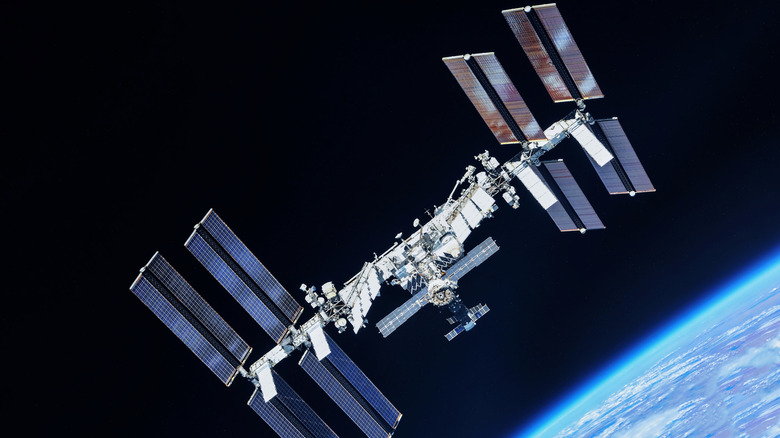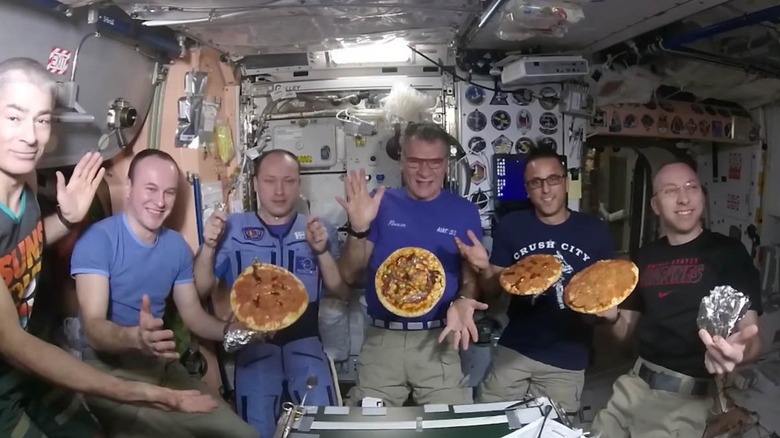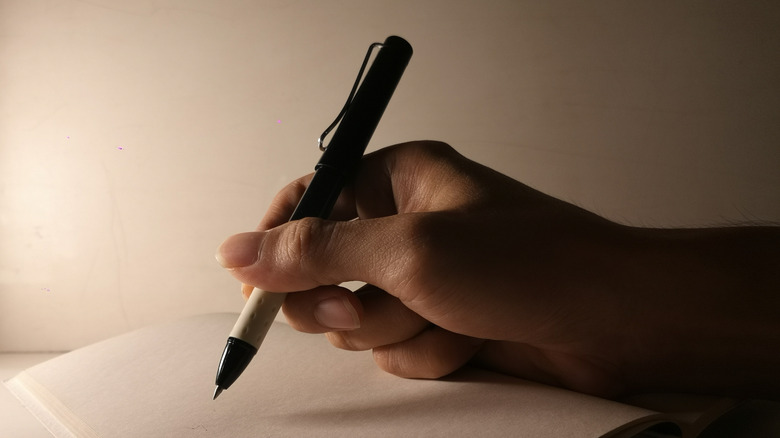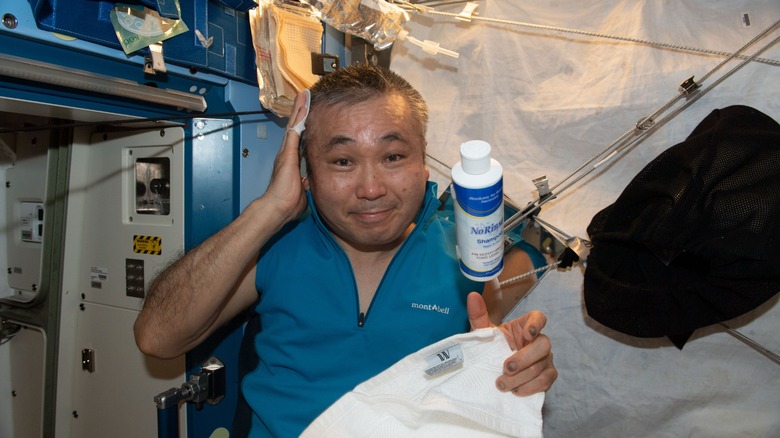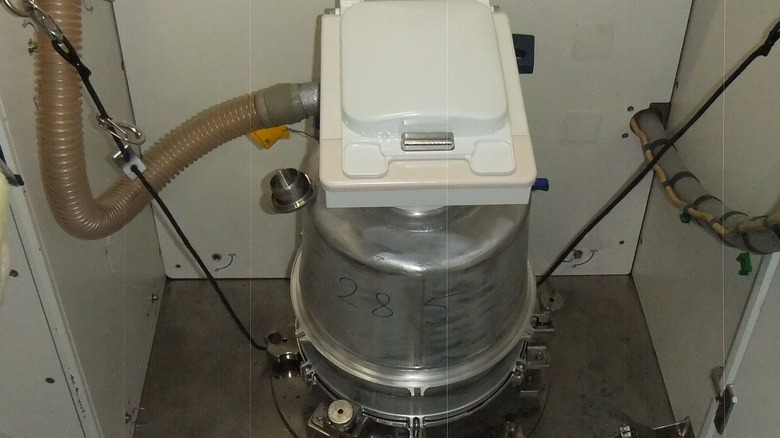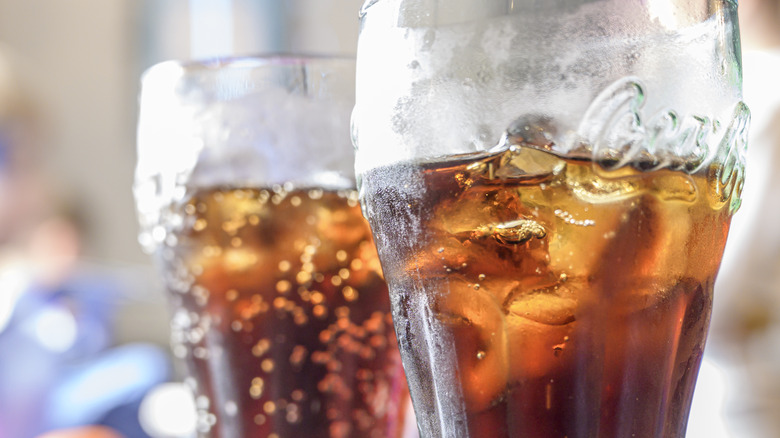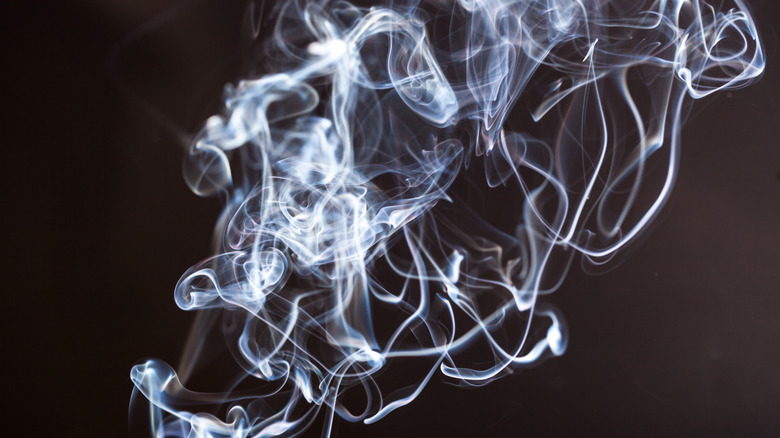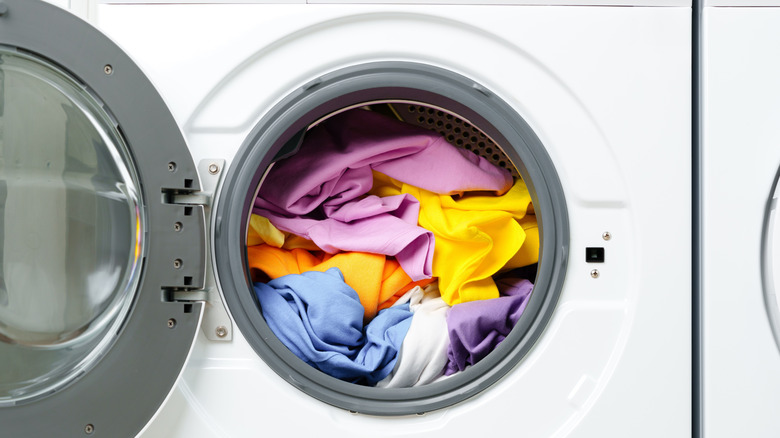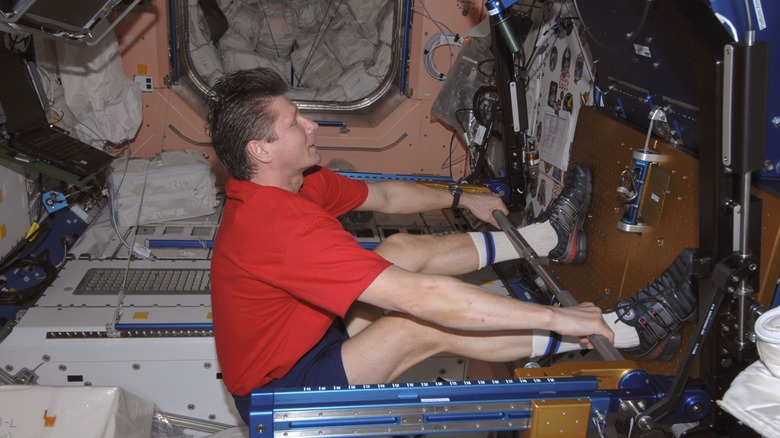Things Astronauts Are Banned From Doing On The International Space Station
We may receive a commission on purchases made from links.
For many of us, the prospect of life aboard the International Space Station sounds exciting and exhilarating. The thought of floating around, being at the forefront of new discoveries, and literally looking down on the rest of the human race is the stuff of dreams. However, alongside all the excitement of a space mission, there are numerous restrictions that mean the astronauts cannot live life as they would back down on Earth.
From errant pencil leads to bodily fluids, many materials behave differently in the reduced gravity found on the ISS, which means the everyday lives of the astronauts aboard have to change dramatically for the six to 12 months that they are away from their home planet. The astronauts on the space station are not on vacation, and the ISS is far from a luxury hotel. Instead, it is a carefully controlled science environment, where conditions are more like a laboratory than a place that its occupants may call home.
From having to adapt their hygiene routine to having their meals closely controlled, astronauts aboard the space station have rules that must be followed for everyone's safety. The success of their mission, and indeed their lives, could be in jeopardy if anyone fails to adhere to those strict regulations. Consequently, while life in space is unique in many ways, there are several things that astronauts are banned from doing on the International Space Station.
Drinking alcohol
Completing your first-ever space walk would be a great reason to open a bottle of bubbly in celebration, but for astronauts on the international Space Station, there is no chance of that happening. Alcohol is banned on the ISS, and the reasons are not all what you may think.
The most obvious reason is intoxication; considering we are not considered fit to drive a car when under the influence, it makes sense that the astronauts in charge of a space station weighing almost 1 million pounds would be expected to stay sober. Additionally, our bodies don't necessarily behave in space the way they would down here on Earth. A glass of champagne is unlikely to greatly dull the reactions of the average person in the comfort of their home, but the altered environment of the space station means that it could have unexpected effects, and no significant studies have been done to find out what they might be.
Another chemical reason to ban alcohol from the ISS is the volatility of the liquid. Ethanol vaporizes easily compared to water, and could potentially affect the water recovery system on the space station. Not only does that mean no favorite tipple for astronauts, but everyday items such as mouthwash and perfume are also off-limits.
Eating crumbly food
Considering the stress of working in space, you may think that the astronauts can turn to their favorite food and snacks for comfort. Unfortunately, crumbly foods such as bread, crackers, and chips are not allowed on the International Space Station, due to the damage they could potentially cause.
If you consider the mess you often make when eating these crumbly foods in your own home, it's easy to work out why they are on the no-go list for the ISS. While gravity does exist there, it is not as strong as the force is on Earth, and the microgravity environment means that crumbs from food could make their way into highly sensitive equipment and potentially cause damage.
Sandwiches and crispy treats are not the only crumbly foods banned on the space station: seasonings such as salt and pepper have the same issue. It's not all bad news, as space food has improved significantly since Yuri Gagarin and John Glenn ate their food from tubes back in the early '60s. Most space food is now dehydrated, but astronauts can occasionally enjoy fresh fruit and vegetables whenever a new spacecraft arrives at the station. There have even been pizzas eaten on the ISS, when in 2017 Italian astronaut Paolo Nespoli had a pizza party with his crewmates (pictured above). So while the food situation on board the space station is heavily regulated, astronauts are still able to eat much better food than their predecessors, and even the occasional fresh treat.
Using regular ballpoint pens
While they technically may not be banned, jotting down a quick note with a run-of-the-mill ballpoint pen is not as easy a task on the International Space Station as it is at home. The microgravity environment means that ink in a regular pen doesn't flow properly, rendering them pretty much useless. Many people believe that astronauts use pencils instead as the solution, and while that was certainly the case during early space missions, any lead that breaks off the tip can potentially float into electrical equipment and cause damage.
The solution is a special type of writing implement known as the Space Pen, which was designed by Paul Fisher and made its space debut in 1968. It uses a special pressurized ink cartridge that allows the ink to flow even in the absence of gravity. They have been used on every American space mission since they debuted on Apollo 7, and there is no shortage of them aboard the ISS. While Sharpie markers and mechanical pencils are also present, the gravity-defying powers of the Space Pen make it a more reliable choice.
Having a shower
Many people take a shower at least once a day, so it might seem like a non-negotiable hygiene ritual. On the International Space Station, however, showers are not allowed, and astronauts have to settle for alternative microgravity-friendly hygiene instead.
Water is heavy and thus phenomenally expensive to transport into space, and the average five-minute shower can use up to 20 gallons of the stuff. The water on the space station therefore has to be used extremely efficiently, so regular washing is off limits. Instead, astronauts have special hygiene pouches that contain everything they need to clean themselves. Liquid soap with a small volume of water is used on their skin, as well as a rinseless shampoo for their hair, all followed by a wipe-down with towels.
Even the small amount of water used for this heavily restricted hygiene routine isn't regular 'fresh' water as it would be on Earth. As much as 80% of the water on the ISS is recycled, which means the astronauts are washing themselves with water that was formerly exhaled water vapor, sweat, and even urine. As off-putting as this might sound, this highly efficient recycling system is what allows the astronauts on the ISS to have regular access to water. So the next time you feel like you could do with a long, hot shower, just be glad you haven't had to go many months without one, as those on the space station have.
Having sex
If you are wondering when the first person will be conceived in space, it won't be any time soon. For now, space sex is officially off-limits, both on the International Space Station and on any other space mission. While NASA Commander Alan Poindexter cited professionalism as the reason, there are a number of practical aspects that would make sex in space a less than desirable act.
The first issue is one of logistics: in the microgravity environment of low Earth orbit, the ability to have intimate relationships while one or both partners floats is going to be complicated to say the least. There is also the issue of bodily fluids, which would not behave in an Earth-like manner, and the unpredictability could mean they end up coming in contact with electric components.
Then there is the matter of privacy. The space station is hardly the ideal place for a romantic encounter, with other astronauts in such close proximity. One final reason that NASA would not be in favor of intimate relations could be the unknown factors surrounding conception. If a person became pregnant while on the space station, there is no knowledge currently of how that pregnancy would develop in such a foreign environment. Until more research is done on extraterrestrial conception, sex will have to stay on the ISS no-no list.
Using a regular bathroom
If you thought that living on the International Space Station was a glamorous job, you probably hadn't considered the toileting situation. With our modern plumbing, we take our toilet routine for granted; once we've done our thing, we flush the toilet and our waste is magically whisked away. In reduced gravity, however, things are a little different.
The initial toilets on the ISS were created in the early 2000s, and were designed to strap the astronauts to the toilet while suction was used to create a vacuum, which prevented any solid waste from escaping. Urinating was even more glamorous, with each astronaut having their own personal funnel to pee into, ensuring the liquid was immediately removed and taken for recycling.
While upgraded toilets were added to the space station in 2020, the basic premise still remains the same. The new toilets are designed to be more female-friendly, and astronauts can empty both their bladders and bowels at the same time, something that was previously impossible. Though water waste is recycled and reused, solid matter has to be disposed of by loading it into cargo craft that return to Earth and burn up in the atmosphere.
Drinking carbonated beverages
Unfortunately for the astronauts living on the International Space Station, carbonated drinks are not allowed, meaning that a refreshing glass of soda after a hard day's work is out of the question. This rule may seem unusual, as coffee, tea, and fruit juices are all approved beverages on the ISS, so why does soda get the red light? As always, it comes down to the change in gravity, and in this case, how the bubbles in the drink behave.
When you open a can of soda on Earth, much of the gas escapes out of the top of the can, leaving behind a pleasant quantity of fizz for you to drink. In microgravity, however, the gas behaves differently and doesn't escape from the liquid in the same way. This means the astronauts would be consuming significantly more gas than they usually would on Earth, which can cause digestive discomfort.
On terra firma, your body can deal with excess gas by expelling it, usually in the form of a burp. But in microgravity, gas in the digestive system is not as willing to escape upward, which can lead to a much more severe case of trapped gas. For this reason, despite the efforts of Pepsi and Coke to win the "Space Cola War" in the 1980s, carbonated drinks are banned from the ISS entirely.
Smoking
This rule may not come as a surprise to anyone, but smoking has always been prohibited on the International Space Station, and for obvious safety reasons. The space station is a carefully controlled environment that contains pure oxygen and other flammable gases, which are crucial for both day-to-day living and experiments the astronauts may be carrying out.
The concept of stepping outside for a cigarette doesn't exist in space, so the only place to smoke would be within the space station, causing a significant fire risk. Of course, with no emergency services to call on, mitigating the chances of a fire is even more important than it would be at home. Even without the risk of explosion, the confined space of the ISS means the numerous toxic substances produced by smoking would impact others on the space station, with nowhere for them to go to escape the fumes. The air filters on the ISS could also be damaged or blocked by cigarette smoke.
Astronauts who were also smokers on Earth have been to space, at least in the early pioneering days of the space race, but from the early '60s onward have been asked not to smoke in public in the months leading up to the space mission. While nicotine replacement therapies can be used on the ISS, with astronauts spending as much as a year on board, attempting to give up smoking entirely in advance of heading into space may be the best option for many astronauts.
Doing laundry
The astronauts on the International Space Station cannot shower for the six to 12 months that they are there, but that's not the only restriction contributing to the stink factor. Doing laundry is also banned on the ISS, so having a clean change of clothes at the ready is a luxury rather than the norm.
As with the showers, the reason for this ban is simple: it would be a colossal waste of water. The cost and logistics of sending up gallons of water to allow astronauts to wash their clothes is impractical, so they have to wear their outfits for long periods of time, and when they are too dirty to continue, they get incinerated. As disgusting as this sounds, it's not quite as bad as wearing clothes for weeks on end on Earth. In space, astronauts are not moving around and sweating as much as we do under Earth's gravity, and since they are not getting dirty outdoors either, there is less of a need to regularly change their clothes.
Since astronauts are aware of these circumstances before they embark on the mission, the clothes they wear will be chosen carefully to reduce the chances of sweat and to keep odor to a minimum. They try to get as much wear out of each item as possible, before eventually packing their dirty laundry into a cargo craft that will hurtle toward Earth and burn up during reentry.
Ditching the exercise routine
The astronauts on the International Space Station typically move slowly and deliberately in their cramped microgravity living space, and they can't just pop out for a jog round the block or head out to the gym before they start their shift. However, reduced gravity can have a negative effect on the body, so taking part in regular exercise is a crucial and mandatory part of a trip to the ISS.
For those of us that spend all of our time on Earth, gravity might not seem all that important for our health. However, our bodies develop and function optimally under the force of Earth's gravity, so if this is removed for a long period of time, it has a negative effect on the health of both muscles and bones. It has been known that exercise would be essential for astronauts to negate this issue since the earliest long-duration space missions, and there is now specialized equipment on the space station for the crew to work out.
Astronauts exercise for on average of two hours per day using equipment such as the Advanced Resistive Exercise Device (ARED, pictured above), which allows them to work their muscles despite the reduced gravity. They also have a special treadmill that keeps them strapped in as they run so that they can maintain contact with the running surface. Keeping to a strict exercise routine means that the astronauts can avoid muscle and bone loss, and keep their fitness levels similar to what they were before the mission began.
